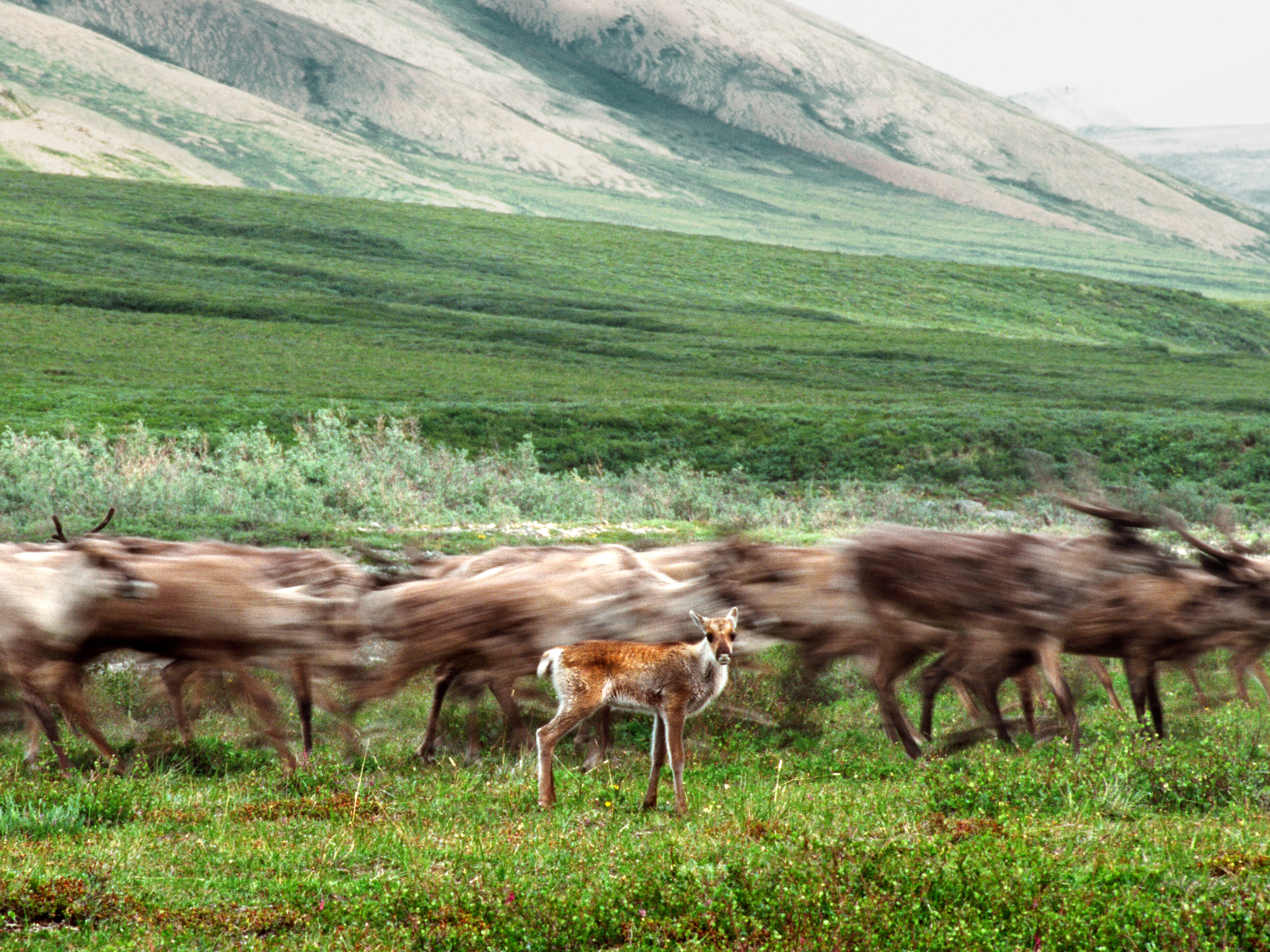
On beings and biomes—caribou and their migrations
By Madison Grosvenor
Each year in Alaska, caribou carve their way across thousands of miles of tundra, rivers, and mountains, etching their ancient paths into the land. These migrations are more than seasonal movement. They are lifelines, connecting calving grounds to winter ranges, linking generations to the tundra.
The caribou and the routes they follow shape entire ecosystems. But as the Arctic warms and industry creeps closer, the future of these herds is becoming less certain.
Putting some spring in your step

The Porcupine caribou migration. Photo by Ken Madsen.
Caribou are an iconic species of Alaska. These antlered, thick-furred and hooved mammals are well-equipped for undertaking long seasonal migrations across the snow and tundra.
Alaska is home to several large migratory caribou herds, each characterized by separate calving areas which they migrate to seasonally, some clocking in a staggering 2,000 to 2,700 miles annually. They have the longest land migration of any mammal.
Every April, spring begins to stir Alaska’s great caribou herds towards their ancient calving grounds.
A 2023 study conducted in the Arctic National Wildlife Refuge revealed that the Porcupine Caribou Herd has been using the same calving grounds to give birth to their offspring for more than 3,000 years. Within days of giving birth, female caribou will shed their antlers, leaving a record of their annual travels dating back to the Bronze Age.
Guided by instinct and memory, pregnant cows will travel 15-20 miles per day towards the landscape they have historically relied on.
The Porcupine Caribou herd is one of the largest herds in Alaska. As of 2017, the herd was around 218,000 strong. Each spring, they migrate back to their ancient calving grounds on the rich coastal plain of the Arctic National Wildlife Refuge.
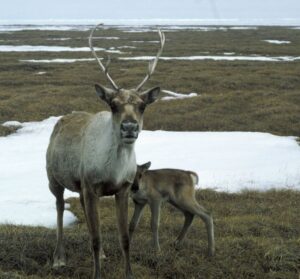
Caribou and calf in the Arctic Refuge. Photo by Kenneth R. Whitten.
Here, the land is dotted with thawing permafrost pools, braided rivers, and fresh green vegetation just beginning to grow in the longer days. The Porcupine caribou herd moves steadily across the thawing tundra eating the new green shoots pushing through the damp ground.
Newborns, still unsteady on their legs, stay close to mom as the herd grazes. The flat and open landscape allows caribou to spot predators from a distance.
This moment on the coastal plain when food, space, and safety briefly align is vital to the herd’s future.
Safety in numbers
Around June, each pregnant female will give birth to a single calf. Each newborn stands within an hour of being born and begins traversing the tundra that very same day.
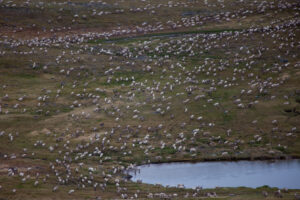
Thousands of caribou group together in “post-calving aggregations” on the tundra. Photo by Joshua Duggan.
In midsummer after calving, caribou group together in “post-calving aggregations” in an effort to avoid predators like grizzly bears and wolves. There is safety in numbers, as their massing overwhelms the predators in the area with an overabundance of food.
Although, that doesn’t stop it all. Predators and scavengers are still around to pick off weaker or stillborn calves.
Around mid-July, huge herds huddle in cool, coastal or alpine areas to escape the heat and relentless swarms of mosquitoes and flies.
As insect pressure eases by July, smaller groups scatter across the tundra to feed. They spend these warm summer days aggressively bulking up on sedges, grasses, willows, and birches.
Seeing red
As autumn reaches Alaska’s tundra with hues of red and gold, bull caribou begin shedding the velvet from their impressive antlers in preparation for the rut.
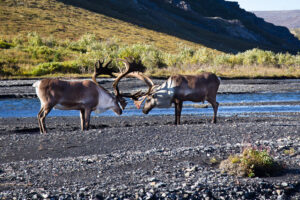
Bull caribou stand head to head in Denali National Park. Photo by Helder Ribeiro.
By September, the tundra becomes a battleground. Mature bulls have packed on more than three inches of fat across their backs and rumps which is used to provide fuel for the intense physical demands of the breeding season. Their necks swell dramatically with rising testosterone, as they prepare to fight.
Sparring typically starts early in the month and peaks in mid to late October. Bull caribou fiercely guard a space around themselves, chasing off rivals to earn a chance at mating.
Battles can be brutal, leaving many bulls injured or spent, easy targets for wolves and bears lurking on the fringes of this Fall event. As the rut wanes in late October, the largest bulls shed their antlers while pregnant cows hold onto theirs through winter.
Unlike bulls, which shed their antlers shortly after the breeding season ends, pregnant female caribou retain theirs through the harsh winter months, often using them to compete for limited food resources in the snow-covered landscape. This seasonal difference means that by late winter, pregnant cows are typically the only caribou still bearing antlers.
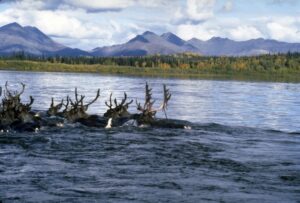
Several Western Arctic caribou swim across the Kobuk River in Kobuk Valley National Park. Photo courtesy of NPS.
Caribou’s movements are likely triggered by weather like declining temperatures and the first snowfall of the season.
The Western Arctic Caribou herd, the largest herd in Alaska, calves in the Utukok River Uplands in the Western Arctic. Once the temperature dips, they begin their journey south to their wintering grounds. Commonly, caribou still cross the Kobuk River within Kobuk Valley National Park during fall migration, as they have done for ten thousand years.
As foraging decreases with winter approaching, they begin to rely more heavily on lichens, a driving factor of their fall movement.
Made for winter
In Alaska, the wintering grounds of caribou herds are shaped by the availability of forage and shelter in the boreal forest and taiga ecosystems. These forests provide critical winter habitat where caribou can access ground lichens, a primary food source, beneath the snow.
Caribou bodies are built to survive Alaska’s winters. Their coat is lightweight and incredibly insulating, with a woolly double layer and hollow hairs designed to trap air. This means their coats are also incredibly buoyant. Caribou are readily outfitted for extreme blizzards and river crossings.
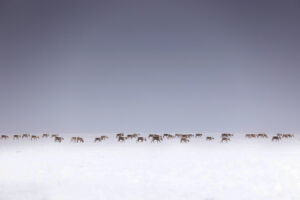
The Western Arctic Caribou Herd travels through and sometimes winters on the Selawik National Wildlife Refuge. This group of caribou foraged for food on the open snowy tundra as wind and snow moved in. Credit: Lisa Hupp/USFWS.
As snow covers the taiga, caribou use their large shovel-like hooves to access the lichens buried below. The hooves even function as a snowshoe in the deep snowdrifts and built-in paddles for strong river currents.
The Porcupine Caribou Herd often winters in the southern Brooks Range and northern Yukon, relying on the taiga’s relatively shallow snowpack and forest cover.
The Western Arctic Herd typically winters in the Nulato Hills and Kobuk River Valley, areas within the boreal forest that offer both forage and protection from wind and predators.
The Teshekpuk Lake Caribou Herd, however, winters farther north on the tundra, staying on the North Slope the whole season.
Each year, these herds make complex decisions about when and where to winter based on snow depth, ice crusting, food availability, climatic variability, and perhaps most importantly— memory.
Memory in motion
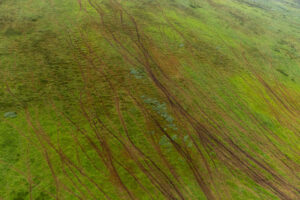
Caribou trails show recent evidence of a large herd migrating through the northern foothills of the Brooks Range. Photo by Lisa Hupp.
Caribou’s seasonal movements are guided by collective memory passed down through generations, allowing caribou to return to historically reliable wintering areas and adapt to long-term environmental changes through shared migratory knowledge.
As winter gradually loosens its grip and daylight begins to lengthen across Alaska, the caribou’s attention shifts northward toward their spring calving grounds. Come spring, caribou return to the same calving grounds year after year in a remarkable display of fidelity, as more than 90% of cows give birth within seven days of their previous year’s timing.
The migratory cycle is not just a response to seasonal shifts, but a deeply ingrained pattern tied to reproductive success, resource availability, and the enduring legacy of learned movement over generations.
But today, the paths caribou have followed for generations are beginning to shift, as new and unfamiliar pressures take shape on the land.
The pulse of the Arctic
Caribou across the Arctic are facing a crisis, driven by the twin forces of climate change and expanding industrial development.
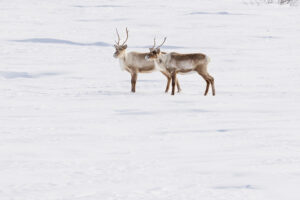
A group of tuttu (“caribou” in the Iñupiaq language) in the Western Arctic Caribou Herd along a winter trail route between Selawik and Ambler. Photo by Lisa Hupp.
In Alaska, the Western Arctic Caribou Herd has plummeted from nearly 500,000 animals two decades ago to just 152,000 as of 2023. Rising temperatures have reshaped the tundra, replacing soft ground cover like lichen and moss with dense thickets of shrubs and young trees. These new plants not only push out the caribou’s preferred food, they also block the ancient migration trails the animals have used for generations.
The threats don’t end with changing vegetation. The Western Arctic herd’s range is under increasing pressure from mining, roadbuilding, and oil and gas development. Roads like the one to Red Dog Mine have already been shown to disrupt caribou movement. Threats like the Ambler road, a proposed 200-mile road into the Brooks Range to access mining districts, would cut through crucial habitat disrupting ancient caribou routes.
Warming winters brought on by climate change have brought more frequent rain-on-snow events that freeze tundra plants under layers of ice, leaving the animals without food and causing large die-offs.
Wildfires are also more frequent, destroying slow-growing lichens and further reducing food sources.
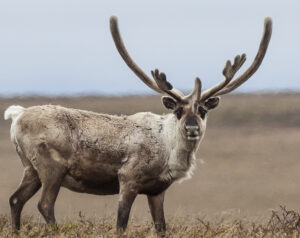
Teshekpuk Lake caribou in the Western Arctic. Photo by Bob Wick.
Even the more stable Porcupine herd, which ranges through northeastern Alaska, is vulnerable as pushes for oil drilling proposed in the Arctic National Wildlife Refuge coastal plain threaten their vital calving grounds.
Across the Arctic, development and climate change are closing in on caribou from all sides, challenging not only the herds’ survival but also the Indigenous communities that depend on them.
For Indigenous communities across Alaska, caribou are far more than just wildlife. They are a foundation of culture, sustenance, and spiritual connection. The Iñupiaq people in northwestern Alaska have relied on the Western Arctic Caribou Herd and Teshekpuk Lake Herd for generations, using every part of the animal for food, clothing, tools, and traditional practices.
In the northeast, the Gwich’in are “Caribou People,” and their lives revolve around the Porcupine Caribou Herd. The herd’s calving grounds in the Arctic National Wildlife Refuge are considered sacred, a place the Gwich’in and allies have fought fiercely to protect from oil extraction.
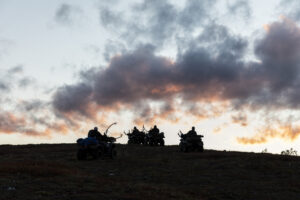
Gwich’in hunters load up their catch from a successful caribou hunt under the sunset. Photo by Keri Oberly.
For both groups, any threat to caribou is a direct threat to their way of life.
“Our traditional knowledge tells us that if you develop in the nursery grounds of the caribou you destroy the caribou, and therefore, destroy the Gwich’in,” said Kristen Moreland, executive director of the Gwich’in Steering Committee. “Protecting the Porcupine caribou herd is a matter of respecting our human rights.”
As climate change and industrial expansion reshape the landscape, these communities are on the front lines, working to defend not just the animals but a way of life that has endured for thousands of years.
Caribou migrations are more than seasonal movement. They are the pulse of the Arctic.
These trails, etched into the land over millennia, link not only habitat to habitat but culture to survival. The same paths caribou use to reach their calving and wintering grounds have long guided the lives of the Iñupiaq and Gwich’in, whose traditions, food security, and identity are woven into the rhythms of the herds. As the Arctic changes, the fates of caribou and the people who rely on them remain inseparable.

Caribou antler shed on the Arctic Refuge Coastal Plain. Photo by Lisa Hupp.
In this moment of accelerating transformation, where warming temperatures and expanding industry press in from all sides, protecting these migratory routes becomes more than an act of conservation. It is a commitment to honoring knowledge carried on four hooves and through generations of memory.
The future of the caribou, and the future of those who walk with them, depends on whether we choose to safeguard the land that sustains them both.
This is the sixth in our “Beings and biomes” series. You can find previous articles below:


